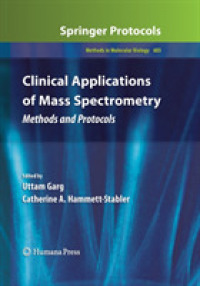- ホーム
- > 洋書
- > 英文書
- > Science / Mathematics
Full Description
This textbook provides a thorough overview of bifurcation theory. Assuming some familiarity with differential equations and dynamical systems, it is suitable for use on advanced undergraduate and graduate level and can, in particular, be used for a graduate course on bifurcation theory. The book combines a solid theoretical basis with a detailed description of classical bifurcations. It is organized in chapters on local, nonlocal, and global bifurcations; a number of appendices develop the toolbox for the study of bifurcations. The discussed local bifurcations include saddle-node and Hopf bifurcations, as well as the more advanced Bogdanov-Takens and Neimark-Sacker bifurcations. The book also covers nonlocal bifurcations, discussing various homoclinic bifurcations, and it surveys global bifurcations and phenomena, such as intermittency and period-doubling cascades. The book develops a broad range of complementary techniques, both geometric and analytic, for studying bifurcations. Techniques include normal form methods, center manifold reductions, the Lyapunov-Schmidt construction, cross-coordinate constructions, Melnikov's method, and Lin's method. Full proofs of the results are provided, also for the material in the appendices. This includes proofs of the stable manifold theorem, of the center manifold theorem, and of Lin's method for studying homoclinic bifurcations.
Contents
Introductory models
Flows and invariant sets
Local bifurcations
Nonlocal bifurcations
Global bifurcations
Elements of nonlinear analysis
Invariant manifolds and normal forms
Lin's method
Bibliography
Index







